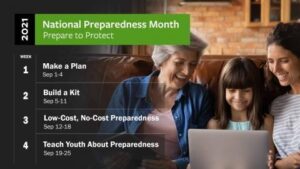
Hurricanes, floods, fires, and pandemics can wreak havoc on businesses. September is National Preparedness Month, which makes it the perfect time to evaluate your plan and prepare for the next emergency. Here are some steps you can take to make sure you, your family, and your business are prepared.
“2021 has proven to be a very active tropical storm and severe thunderstorm season thus far,” says Brian LeCates, acting director of Talbot County Department of Emergency Services. “It’s important to plan and prepare now as we already experienced adverse effects for the hazards associated with our frequent summer thunderstorms.”
- Talk to friends, family, and employees about how you will communicate before, during, and after a disaster. Be prepared to call, text, and/or email employees to keep them up-to-date on the status of your business. The Federal Emergency Management Agency has a free brochure on communications strategies during crisis.
- Consider weather and tide apps for your phone such as “Tides Near Me” and “AccuWeather” both of which are free and can keep you
 up-to-date on changing weather patterns and tides. Tune into local radio and television stations for weather alerts.
up-to-date on changing weather patterns and tides. Tune into local radio and television stations for weather alerts. - Gather supplies including food, medicines, and personal products for those living in your home and encourage employees to do the same in theirs. It’s also wise to have supplies at work such as a first aid kit and snacks should you need to shelter in place. Ensure you have extra batteries and drinking water in the event electricity is interrupted. Here is a checklist to help you determine what is important.
- Severe thunderstorms and hurricanes are common on the Eastern Shore. Check your business and home for things that could cause damage in a storm, such as low hanging tree branches, unsecured trash cans, and outdoor furniture.
- Be prepared to either shelter in place or evacuate employees as necessary, depending upon the situation. If your business must close of a period of time, have plans in place to allow employees to work from home if possible. The pandemic over the last year has taught us valuable lessons when it comes to continuity of operations.
- Storm surge and high tides are also common in coastal areas. Talbot County’s storm surge map helps residents and business owners find out surge values for their area. If flooding is expected take measures to protect important documents and equipment.

“Our private sector partners are what makes our community so resilient and strong,” says LeCates. “The lasting relationships we have built, especially during the pandemic, will hold true as we continue to prepare for, respond to, and recover from emergencies to come. We urge businesses to visit our website for preparedness information, for their business, employees, and homes.”
For more information about preparing for hurricanes and other disasters, visit the Talbot County Emergency Services website. Helpful resources include a tip sheet on hurricanes and storm surge maps for the county.
The Maryland Emergency Management Agency has published a helpful guide to use when hurricanes are predicted. MDHurricaneEvacGuide
The Federal Emergency Management Agency has developed a free toolkit for businesses and a booklet called “Every Business Should Have a Plan” to help businesses prepare for hurricanes.